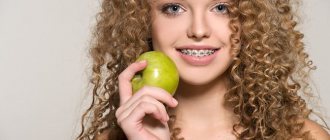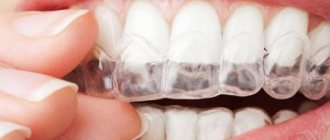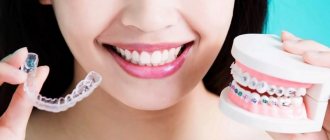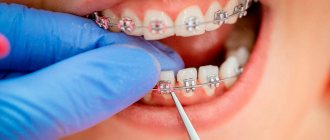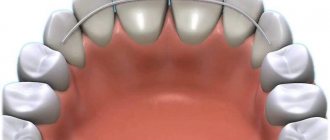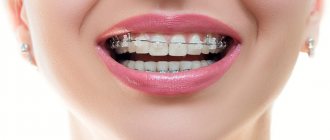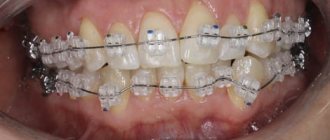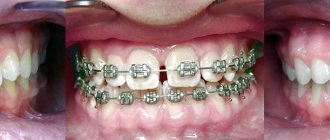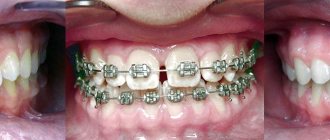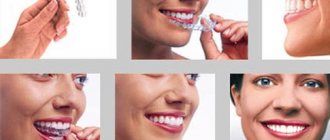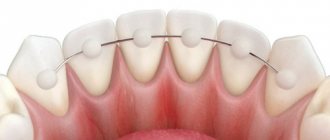Devices of this type are used to confirm the results already achieved and maintain the resulting therapeutic effect until the body completes a morphological or functional restructuring. Under such circumstances, retainers act as a means to reduce the incidence of relapses. The need for their use is justified by the fact that histological processes in bone tissue after external changes are much slower and do not always correspond to the changes that are introduced into the dental cavity under the influence of a special apparatus.
Retention devices are used to hold the dental cavity, an individual tooth in a new position, without limiting the oral cavity. In addition, such a device looks quite aesthetically pleasing and does not exert a force on the patient’s jaw, thereby causing a lot of unpleasant moments.
Retention devices: removable and non-removable
The retention period is the period after braces are removed during which you need to wear a removable and non-removable retainer.
A retention device (retainer) is a holding device that allows you to maintain the achieved result. It can be removable or non-removable (see video).
A permanent retainer is a piece of braided wire (arch) that is glued to the inner surface of the teeth from canine to canine, to each tooth using a special light-curing material. Does not interfere with eating, does not impair diction, does not require special care and frequent visits to the orthodontist. It feels like a filling. Stays in the mouth for a long time after removing braces (up to 5 years or more).
A removable retainer is a transparent mouthguard for all teeth of the upper and lower jaw. It is invisible to others, but there are inconveniences associated with the need to remove the aligner while eating and brushing your teeth.
The duration of wearing depends on the patient’s age and the initial clinical situation. For most patients, the removable retainer should remain in the mouth for at least 20 hours per day for 1 year. And during the 2nd year, get dressed at night. But this regimen is individual for everyone and is determined by your doctor.
If teeth have been removed and the upper or lower jaw is in an abnormal (narrowed) position, wearing retainers will prevent the jaw from narrowing back or opening up the spaces where the teeth were removed.
The problem of maintaining the results obtained has been and remains a headache for all orthodontists. This problem is due to the fact that many patients believe that only a period of wearing braces is enough to maintain the result and wearing retainers is not so important. Unfortunately, they notice the changes in their teeth too late, when the situation can be corrected only by installing braces again. Therefore, you can often hear: “My friend also wore braces, and when they were removed, his teeth became crooked again.” Most likely, this “friend” did not wear retention devices.
First of all, you will be able to maintain your results if you strictly follow the recommendations of your orthodontist for constantly wearing the retention apparatus in the mode that will be prescribed for you.
The final stage of treatment
Once each tooth has taken its place, therapy cannot be stopped. Indeed, over time, the curvature may develop again, and then all efforts will be useless. It is important to securely fix them in the new position. This is the main purpose of using retention devices. They must be used until the adaptation stage is completed (the period is determined by the doctor). When worn, they are imperceptible and hardly noticeable. It's not difficult to get used to them. Care does not take much time, there is no negative impact on the enamel or gums, and, as practice shows, the result is not long in coming.
Instructions for the care and monitoring of a fixed retention device
- 1. Monitor the integrity of the permanent retainer; periodically check it with your finger in front of a mirror with good lighting. If you feel the retainer moving around any of your teeth, this is a reason to visit your orthodontist. By examining the condition of the retainer in the mirror, you can independently determine the absence of material on one of the teeth, which also requires a slight correction by your doctor.
- 2. In a situation where a non-removable retainer has completely peeled off from all teeth, this is critical and requires an urgent visit to the doctor. If a non-removable retainer comes off completely, it is mandatory to wear a removable retention mouth guard around the clock until you visit a doctor and install the retainer in its original location.
- 3. In no case should you use a toothpick or other objects to pick out food debris from under the retainer; it is more advisable to use a toothbrush.
- 4. Approximately once every 6 months it is necessary to have professional teeth cleaning (if ultrasound is used during cleaning, it is very important that the doctor has sufficient experience working with orthodontic patients). Incorrect operation of the ultrasonic tip in the retainer area can lead to damage to its integrity.
Features of the retention period
Duration. The period of use of retention devices is determined by the treating orthodontist. The more the dental system has been changed, the longer it will be. Additionally, it is influenced by the state of the dental system, the speed of adaptation of its tissues to the new position of the teeth, and other features. The retention period can last as long as the main phase of treatment, or longer.
Daily hygiene. This is done in the same way as when using braces. The constant use of metal plates fixed to the surface of the enamel can increase the risk of its demineralization, accumulation of soft plaque, and the appearance of tartar. To keep your teeth healthy, you need to visit the dentist once every six months for a preventive examination, professional hygiene, and enamel remineralization. These visits are combined with control examinations by an orthodontist, who can adjust the retention apparatus, change recommendations for its use, etc. If a non-removable retainer comes off, causes discomfort, etc., an orthodontist is visited urgently.
Additional treatment. Together with mouthguards or retainers, functional orthodontic devices (regulators, bionators, activators, etc.) can be used at the final stage of treatment. They are installed to finally align the position of the teeth while the adaptation process is underway.
During the retention period, the shape of the dentition no longer changes, and there will be no visible, noticeable results at this stage of treatment. It is important so that the teeth acquire a stable position, and the dental system itself successfully adapts to it.
Dentists at the Dentospas clinic use individually manufactured devices during the retention period, which ensures control over the stability of the teeth. This ensures that the results of orthodontic treatment will not be lost, and the patient’s smile will remain beautiful for a long time.
Instructions for the care and wearing of a removable retention device
- 1. On the first day of wearing a retainer, you may experience slight pain in the area of some teeth. This is a temporary phenomenon that goes away after a few hours.
- 2. In the first days after installing the mouth guard, increased salivation is possible, which goes away after 1-2 days.
- 3. There may be a slight change in diction in the first days after installing the mouth guard. Diction will be fully restored after 2-3 days of regularly wearing the mouth guard.
- 4. If during wearing you notice that the edges of the retainer scratch the mucous membrane of the tongue or cheeks, then in this case you need to contact your doctor to have these sharp edges corrected.
- 5. Under no circumstances should any food be consumed in a removable retainer. This can lead to rapid breakdown of the device.
- 6. You cannot smoke with a mouthguard in your mouth or take coloring liquids (red wine, juices, Coca-Cola, etc.). This may cause the mouthguard to lose its clear properties.
- 7. Do not immerse the mouthguard in hot liquids (more than 40 degrees). This may lead to its deformation.
- 8. In those moments when it is necessary to remove the mouth guard, watch where it is located, because Most often, its loss occurs in cafes, bars and restaurants, during meals.
- 9. When removing the mouthguard, do not put it in your clothing pockets without a special container; if you forget about it, you can easily damage it.
- 10. You need to clean your mouthguard 2 times a day with a toothbrush and soap. You need to be very careful when cleaning. Significant bending of the mouth guard can lead to cracks in it.
- 11. If you have lost your mouth guard, you must urgently make an appointment with a doctor to take impressions and make a new mouth guard. This needs to be done as quickly as possible, because... Without a mouth guard, your teeth can quickly change their position and not for the better.
- 12. If you are far from the clinic, or your doctor is on vacation, other doctors at our clinic, or any dental institution in your place of stay, can take impressions and make plaster models for you.
- 13. The service life of the mouth guard is about 1 year, after which it is necessary to make a new mouth guard. The patient pays for a new mouthguard. In cases where a mouth guard is lost or broken, the patient bears the cost of making a new mouth guard.
PS You may also find it useful to learn how to care for braces.
If you were treated in another clinic, and for some reason you did not have a retention mouthguard installed, and after reading this page you have a desire to maintain the result, then we can make a retention mouthguard for you.
Fixed orthodontic equipment
1. Braces systems
- Self-ligating metal brace system Damon Q
is an external non-ligating brace system from one of the leaders in the production of braces - Ormco (USA). In self-ligating brace systems, the arch is attached to the bracket not with a ligature - a special wire or rubber band, but with a lock that is located on the bracket. The arch slides freely in the bracket groove, so the orthodontic forces in such a bracket system are very small and physiological. Compared to the classic ligature bracket system, the Damon Q self-ligating bracket system is faster. The patient will come to the orthodontist less often with her. The dimensions of the Damon Q braces themselves are reduced, so the metal bracket system looks very aesthetically pleasing. Due to the low physiological forces, such braces can be used in the treatment of patients with periodontal pathologies. Damon Q braces are suitable for patients of any age. In our opinion, this is one of the best, reliable and comfortable braces systems at an affordable price.
- Self-ligating ceramic bracket system Damon Clear | Clear 2 is
an aesthetic, invisible bracket system and its newer modification from the Damon family, from Ormco (USA). Damon Clear is often called sapphire braces because their ceramic has unique properties and resembles sapphire. It is completely invisible on the teeth, does not stain or change color during treatment. At the same time, the bracket system has all the advantages of self-ligation - it creates low forces on the teeth, and the speed of treatment with it is higher than with a conventional one. With it, the patient spends less time in the orthodontist’s chair and visits the clinic less often. Damon Clear is suitable for orthodontic treatment of patients of all ages.
- The MINI Diamond ligature metal bracket system is
a very reliable classic ligature bracket system with a reduced bracket size from our favorite manufacturer - Ormco (USA). Due to its practicality and aesthetics, the MINI Diamond brace system has become the favorite brace system of teenagers all over the world. And its elastic ligatures, which hold the orthodontic arch, are a stylish and bright accessory that lifts your spirits. This is one of the thinnest and most comfortable braces to wear. Moreover, its price is more than affordable. Ideal for treating children and adolescents.
- Ligature sapphire bracket system Clarity is
an aesthetic bracket system from 3M Unitec (USA). Sapphire braces are made from single crystals of artificial sapphire. Such braces completely “dissolve” on the teeth, due to the fact that artificial sapphire has the refractive index of saliva light. The Clarity sapphire bracket system features a comfortable, smooth lock, the base of which adheres well to the surface of the tooth. But at the same time, it does not create problems during removal, like many of its sapphire counterparts. Used to treat mainly adult patients.
- Incognito lingual brace system is
internal, i.e. A bracket system installed on the inner - lingual surface of the tooth. It is made from an alloy with a high gold content. Lingual braces "Incognito" are completely invisible to others, because... located BEHIND the teeth. At the same time, due to the low, comfortable profile of the locks, the patient experiences virtually no problems with diction and eating during treatment. The Incognito bracket system is produced individually based on computer modeling of treatment based on a 3D model of the patient’s jaws. Braces and a set of arches for them are manufactured “for each patient” fully automatically, which eliminates the human factor. This technology gives a lot of advantages to the doctor when planning treatment, and allows the patient to see the result of treatment with braces even before it begins. Lingual braces are only suitable for adult patients.
- Partial braces
are braces that are not installed on all teeth, but only on individual teeth. Most often, a partial brace system is fixed to the front 4 incisors and the last 2 molars - this configuration is called a “2x4 device”. They are used to treat children aged 8-10 years in mixed dentition. Very effective when there is not enough space for teeth to erupt. We use them on both the lower and upper jaws.
In the partial braces system we use 2 types of braces:
- Self-ligating metal Damon Q,
- Ligature metal MINI Diamond.
2. Additional fixed orthodontic appliances
- The Power Scope device is a standard-issue orthodontic device that is attached to the arches of the bracket system. Used to correct bite in difficult cases. Combines high efficiency, wearing comfort for the patient, convenience and ease of installation. In our clinical practice, he excels in various types of complex tooth movements: correction of midline asymmetry, closing and opening gaps in the dentition. It is installed on the bracket system for a certain period of time, then treatment continues in the standard mode.
- Quad Helix device . In Russian it is pronounced as "kvadhelix". This is a wire palatal structure (buggel) supported on molars for the correction of the upper dentition and expansion of the upper jaw. Sometimes we use it as a preliminary stage before treatment with braces. It is used to treat both adults and children. The device is small in size, unnoticeable when talking and smiling, and gives very good therapy results. The disadvantage of Quadhelix is the need to get used to the design.
- A device for preserving space after tooth extraction - an orthodontic spacer.
Indispensable for early removal of baby teeth, when there is more than a year left before the natural eruption of permanent teeth. To prevent adjacent teeth from shifting to the place of the removed one, the orthodontist puts on a special structure that will preserve space for the future permanent tooth. Such a device is made individually and can have a different design. Sometimes orthodontists can get very creative to ensure that it is effective and comfortable for your baby.
Reasons for relapse
In some cases, even treatment with retention ends in relapse. The reason for this may be the following factors:
- Failure of the patient to comply with the doctor's recommendations. Most often this is a violation of the wearing regime of removable devices.
- malfunction not corrected in a timely manner .
- Transition to the retention phase with unfinished treatment. In particular, without achieving stable occlusion.
- Incorrect treatment. For example, relieving crowding without providing adequate space in the row, which causes the teeth to tilt forward.
- Correcting one anomaly (in particular, crowding of the anterior teeth), but ignoring another (for example, violation of the occlusion of the posterior teeth).
Measures to help combat relapse:
- Preservation of the original shape of the mandibular dentition.
- Maintaining intercanine distance.
- Use, if necessary, fibrotomy (dissection of periodontal fibers to prevent relapse of rotation).
- Separation (division) of the lower incisors along the proximal surfaces.
- Grinding of occlusal surfaces of supercontact teeth.
When consolidating the result, it is necessary to take into account the following points and patterns:
- The length of the lower jaw dentition decreases with age.
- Advancement of the lower incisors threatens stability.
- Knowing the position and condition of the roots allows you to choose the optimal method of correction and retention.
If all measures to combat relapse prove futile, the patient is prescribed lifelong retention with non-removable devices.
How to consolidate the result?
The practice of orthodontists shows that relapses are most often caused by the early removal of retainers or their inconsistent wearing. If you follow all the recommendations of the orthodontist and attend routine examinations in a timely manner, the results of treatment will last for many years and your smile will remain irresistible.
When treating complex anomalies, the doctor may recommend additional observation by an orthopedist, since posture affects the bite and can “pull” it back to an incorrect position, but this is still not an ordinary case.
How long does this stage last?
Standard – twice as long as the treatment lasted. That is, with treatment for a period of 1 year, the retention stage lasts at least two years. But often, even after this period, it is too early to completely part with the aligners: many patients noted that the teeth may still begin to move. There is a risk of partially or even completely losing the result that was achieved over the whole year.
You can independently determine how great the risk of regression is: do not wear retainers for 1-2 days, and then put them on and listen to your feelings. The aligners were put on with little effort, is there a feeling of pressure on the teeth, especially on those whose position before treatment was more deviated from the norm? This means that microscopic movements of the teeth have already occurred in 1–2 days. It is too early to interrupt the retention stage.
When interrupting the retention stage, it is important not to rush
Why is retention needed?
- Braces have a mechanical effect on the bone and mucous tissues of the periodontal tissues, and after removing the plates, time is needed for the reorganization of these tissues.
- At the end of the course of wearing braces, the teeth are in an unstable position, pressure from the soft tissue creates a risk of relapse.
- In adolescents, changes associated with tooth growth can also cause some changes in the bite after treatment, so retainers become a necessary measure.
Removable structures
Very easy to use, they can be removed independently during meals, hygiene procedures, and if therapeutic dental treatment is necessary. Also easy to install back. There are several types:
- Polymer transparent retainers-aligners, reinforced with a metal arch. They fix the position of the teeth along the length of the jaw and are invisible to others. Used constantly, excluding food intake and care procedures.
- Orthodontic plates consist of a plastic base and fixing metal elements. Basically, the designs are worn at home and put on before bed.
- Positioners keep the teeth in the correct position and restore the tone and density of the gum tissue. Made from elastic polyurethane, they are easy to use and do not cause allergic reactions. Show high effectiveness for minor occlusion disorders.
Removable orthodontic appliances are made within 3-7 days using individual impressions.
Key Aspects
The retention period is the final stage of treatment of a dental anomaly, which follows the active treatment and serves to consolidate the achieved movement.
The tendency of teeth to return to their previous position after correction is explained by several reasons, primarily by different rates of bone resorption and formation.
Bone tissue in the area of compression is absorbed faster than new tissue is formed in the area of tension. Because of this, after treatment is completed, the teeth may begin to shift back to their original position.
Another reason for relapse is the fact that transformations in bones occur faster than in soft tissues.
Elastic deformations that persist in periodontal tissues and periodontal collagen fibers force the alveoli, along with the teeth, to partially return to their previous position.
The following factors also contribute to relapse:
- Dysfunction of masticatory and facial muscles.
- Bad habits of children, the ongoing formation and growth of the bones of their dentofacial apparatus.
- Unstable occlusal relationships of the upper and lower teeth (mismatch of cusps and cavities).
- Discrepancy between the sizes of the upper and lower segments of the dental arches in the frontal region.
- Premature contacts of teeth (super contacts).
- Pathological changes in periodontium.
Conditions of stability
In order for the position of the teeth to be stable after movement, the following conditions must be ensured at the end of treatment:
- The first molars are in the 1st class according to Engle.
- Stable multiple fissure-tubercle contacts have been achieved.
- The overlap of the incisors is normal (there is no sagittal fissure).
- The roots of the teeth are parallel (according to x-ray results).
- There are no gaps between teeth and no rotation of individual units.
- The incisor torque is normal (no tilt back and forth).
- The interincisal angle corresponds to the norm (130°-140°).
- The width of the dental arch along the canines is unchanged.
The mechanism of bone tissue restructuring during tooth movement and some nuances.
Visit here to learn more about orthodontic teeth traction.
At this address https://orto-info.ru/ortodonticheskoe-lechenie/osnovnoy-period/distalizatsii-molyarov.html we will consider the apparatus used for distalization of molars.
Guarantees
Preservation of the result can be ensured only if the regime of wearing retention devices is observed, as well as other conditions specified above. Otherwise, there may be curvature of the teeth, deterioration of the bite and functions of the dental system, the aesthetics of the smile, for which the Contractor is not responsible and which are subject to re-treatment at the current price list. The warranty period for retainers is 12 months from the date of their installation. This means that during this period, retainers are repaired free of charge if they break, unless it is the patient’s fault. If the patient is at fault, or after the specified warranty period has expired, the repair (replacement) of retention devices is carried out according to the currently valid price list. The service life of fixed retainers is 5-7 years, removable retainers are 1 year, removable plates are 3-5 years.
Advantages of the Alfa-Vid clinic
The Alfa-Vid Dental Center invites patients in need of bite correction to a free consultation. At the initial appointment, the doctor will carefully examine the oral cavity and, depending on the clinical case, will offer the best option for retention treatment. We guarantee:
- compliance with international quality and safety standards;
- individual approach;
- comprehensive problem solving.
If necessary, the patient has access to emergency assistance from doctors of related dental specialties (therapist, surgeon, etc.). The clinic is equipped with advanced European-level equipment, and dentists use high-quality materials in their work.
